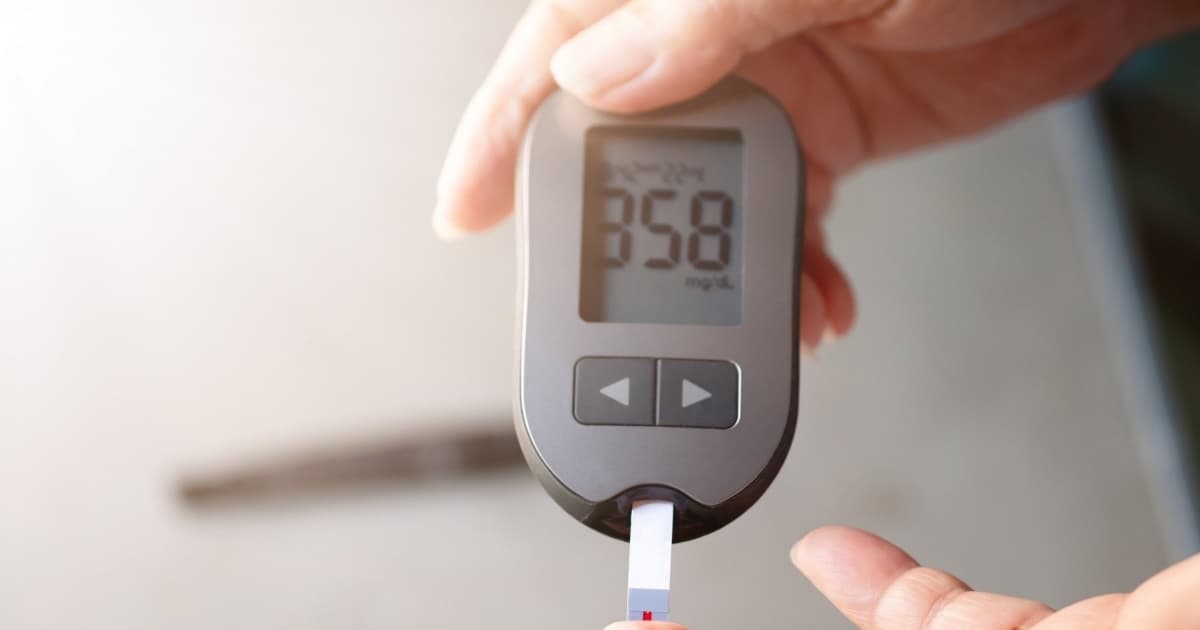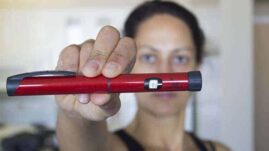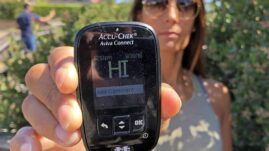If you live with diabetes, you probably know that life with the condition is similar to walking on a tightrope.
Staying in range without too many high (hyperglycemic) and low (hypoglycemic) blood sugars is a constant balancing act.
But what levels of blood sugar are actually considered dangerous?
This article will explore the issue and provide advice for how you can help manage both the highs and lows of diabetes, literally!

Table of Contents
What is a normal blood sugar level?
According to the American Diabetes Association, a normal fasting blood sugar (in the morning when you haven’t had anything to eat or drink except water for 8 hours ) is less than 100 mg/dL.
A fasting blood sugar reading of 100-125 mg/dL indicates prediabetes, and a reading above 125 indicates diabetes.
| Fasting Blood Sugar | Result |
| Less than 100 mg/dl | Normal |
| 100 mg/dl to 125 mg/dl | Prediabetes |
| 126 mg/dl or higher | Diabetes |
(If you live outside the US and are used to measures in mmol/L, just divide all numbers by 18)
If you test your blood sugar two hours after eating or drinking something containing sugar instead (an oral glucose tolerance test), the numbers to look for are:
| Oral Glucose Tolerance Test | Result |
| Less than 140 mg/dl | Normal |
| 140 mg/dl to 199 mg/dl | Prediabetes |
| 200 mg/dl or higher | Diabetes |
You can learn more in the in-depth article: What Are Normal Blood Sugar Levels?
The danger of high blood sugar
Having high blood sugar means there is too much sugar in the blood because the body is lacking in insulin. This can happen for many reasons, including not taking enough insulin exogenously, too little exercise, eating too much, or even stress, hormonal changes, or lack of sleep.
High blood sugar is dangerous, but it’s important to remember that high blood sugar is mostly dangerous over prolonged periods of time (unless you are in DKA, more on that below).
This means that, for the most part, your blood sugar at diagnosis will not cause long-term complications, and the spike you saw last week from eating an ice cream sundae won’t impact you over the long term.
But chronic, prolonged high blood sugars (think a lifetime of diabetes with an average blood sugar of 200 mg/dL) will cause diabetes complications in most people.
What is considered high blood sugar?
Blood sugar levels are considered high in people with diabetes once they’re more than the 125 mg/dL that indicates a diabetes diagnosis. However, having a blood sugar of 145 mg/dL usually won’t cause any problems (especially if you’re going to sleep or planning to exercise).
For most people, high blood sugar becomes symptomatic once the blood sugar level reaches between 180-200 mg/dL.
Blood sugars above 200 mg/dL need to be treated immediately with insulin (and water and exercise are helpful, too), and any blood sugar over 250 mg/dL requires that you do a urine test for ketones, to make sure you’re not spiraling into diabetic ketoacidosis (DKA).
This is when the body’s blood turns acidic due to prolonged, dangerously high blood sugar levels and ketones in the blood. This can be fatal if not treated immediately.
This can occur when one is sick or battling an infection, due to a pump infusion site failure, or even if you forgot to take your insulin for a few days.
Unfortunately, about 25% of newly diagnosed people with type 1 diabetes are diagnosed when they are already in DKA.
If you are experiencing a blood sugar higher than 250 mg/dL along with moderate to high ketones for several hours and cannot get your blood sugar down, contact your doctor immediately and seek emergency medical attention.
People with diabetes are at heightened risk of falling into a diabetic coma from high blood sugar once their blood sugar levels reach 600 mg/dL or higher.
At this point, your blood turns thick and syrupy, and excess sugar passes from your blood into your urine, which triggers a filtering process that draws large amounts of fluid from your body (called “diabetic hyperosmolar syndrome”).
This is a true medical emergency, is extremely dangerous, and can be life-threatening. If you are in this situation, you should call 911.
What are the symptoms of high blood sugar?
The symptoms of high blood sugar can vary depending on severity.
Early signs and symptoms of high blood sugar
When your blood sugar is around 200 mg/dL, but not yet dangerously high, you may experience the following symptoms:
- Increased thirst
- Frequent need to urinate
- Fatigue
- Achy muscles
- Slightly blurred vision
- Headache
Later signs and symptoms of high blood sugar
If you have ketones and are at risk of falling into DKA, you may experience these symptoms:
- Nausea
- Vomiting
- Fruity-smelling breath
- Dry mouth
- Weight loss
- Weakness
- Extreme fatigue
- Confusion
- Severely achy muscles
- Extremely blurred vision
- Shortness of breath
- Coma
If you are experiencing any of the later-stage symptoms of high blood sugar, seek immediate medical attention.
The danger of low blood sugar
Low blood sugar, also known as hypoglycemia, can become a lot more dangerous more quickly. Hypoglycemia, if left untreated, can quickly result in diabetic coma and death.
Low blood sugars will not lead to permanent complications in most cases (unless someone experiences brain swelling and a traumatic brain injury from falling into a diabetic coma) but cause frequent, short-term complications in the form of being physically unable to function when experiencing a low. They require fast-acting glucose (or a shot of Glucagon) as treatment.
Symptoms of low blood sugar can hit different people at different times, and some people may not feel their low blood sugars at all (called hypo unawareness), which can be very dangerous.
Continuous glucose monitoring systems and diabetes alert dogs can help people detect their lows earlier, before they become extremely dangerous.
Hypo unawareness occurs in about 40% of people with type 1 diabetes, and less frequently in people with type 2 diabetes.
Additionally, one study showed that the average person with type 1 diabetes experiences two episodes of low blood sugar per week!
Low blood sugars can happen for many reasons, all of which result from too much insulin in the bloodstream and not enough glucose for the body to function properly.
Reasons can be anything from taking too much insulin for food, to accidentally over-bolusing with an insulin pump, to not finishing a meal, to drinking alcohol in excess, or even after physical exertion and exercise while not reducing basal insulin settings appropriately.
What is considered low blood sugar?
For the average person with diabetes, low blood sugar means anything under 80 mg/dL (for pregnant women, who need to have tighter control, low blood sugars are anything under 60 mg/dL).
Very low blood sugars are any readings under 40 mg/dL. Anything under 40 mg/dL is considered extremely dangerous and potentially fatal.
A person is at a significantly higher risk of falling into a diabetic coma if they cannot get their blood sugar above 40 mg/dL for several hours.
If a person is experiencing a severe low, and they are unable to chew food or swallow liquids, they will require an emergency shot of Glucagon (typically in the thigh muscle or buttocks).
What are the symptoms of low blood sugar?
- Confusion
- Anger/Frustration
- Sweating/Clammy
- Shaky, unsteady movement
- Rapid pulse
- Hunger
- Lethargy
- Irritability
- Dizziness
- Difficulty speaking
- Muscle weakness
If you are experiencing an extremely low blood sugar, which is anything less than 40 mg/dL, that is not responding to fast-acting glucose or glucagon, and you have taken fast-acting insulin within the previous 2 hours, call 911 and seek immediate emergency medical attention.
This condition can be life-threatening if not treated.
Tips for avoiding high and low blood sugars
Walking the tightrope of a life with diabetes is not easy.
We need to strive every day to make sure that we don’t let our blood sugars go too high or too low, and that can be exhausting.
Here are some strategies to help keep your blood sugar in balance:
- Eat similar foods and meals that have predictable carbohydrate counts
- Cook food at home, so you know all of the ingredients in your meal
- Keep to a routine, and eat at the same times every day
- Get enough sleep!
- Double-check your insulin doses to make sure you’re not taking too much, nor too little
- If you’ve counted carbohydrates for a meal and dosed insulin for those carbohydrates, eat everything
- Check the expiration dates on your insulin regularly
- Always have fast-acting glucose and glucagon nearby
- Take all insulin and diabetes medications as prescribed
- Wear a CGM or get a diabetes alert dog to help you detect low blood sugars if you’re experiencing hypo unawareness
- Wear a diabetes alert bracelet
- Don’t over drink alcohol on an empty stomach
- Work with your doctor to increase or decrease your insulin needs as you experience life changes (puberty, pregnancy, aging, training for a race, etc.)
- Treat all high and low blood sugars early and often, before they become dangerous
High and low blood sugars can be a nuisance, but they don’t always have to become scary and dangerous.
Enlisting these strategies can help you better prepare for and (hopefully) prevent many of them in the future.





IDA BOND
iM 88 AND OLD SCHOOL IIKE SO NEVER LEARNED THE SHORT FORMS OR NEWLY USED WORDS TO DESCRIBE MOSLY medical forms so where in HEAVEN CAN i GET SOME CARD OR LIST TO HELP ME.?
Christel Oerum, MS
I’m not sure. Your doctor’s office might have pamphlets
Pramod
Important and critical for both T1 and T2 Diabetes patients to understand the basics. They can manage themselves so as not to land in an emergency situation.
Keep up the good work!!
Jeff
In several instances I wasn’t sure how to interpret the blood sugar numbers. There are quite a few mentions of 200 and 240 mg/dl, but does that mean a brief peak reading after a meal, or prolonged period such as a fasting period reading first thing in the morning?
I’ve had a reading of 210 an hour after starting a meal, but 2 hours after it will be 145 or so. If it were 210 two hours after a meal, that would be scary!
So maybe more detail in time length involved (acute or chronic) perhaps?
Thanks.